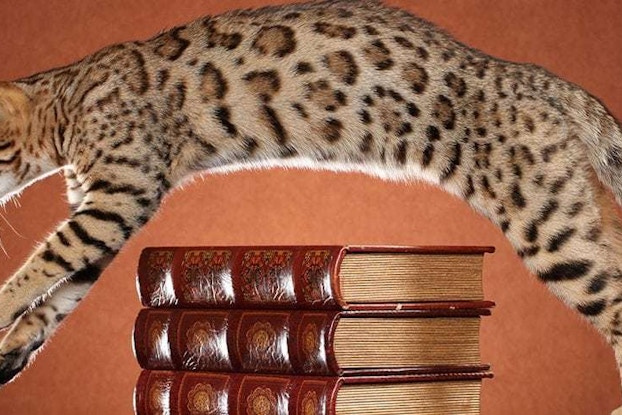
Anthony Hutcherson said: “I like to say that cats are entrepreneurs, and dogs are on welfare.”
Hutcherson might be slightly biased. He is, after all, currently mid-Atlantic regional director for The International Cat Association. He’s also the proprietor of the Jungle Trax Cattery, a Maryland-based cattery that breeds the exotic Bengal cat.
The Bengal cat is not your ordinary domestic feline. With its spotted fur, it resembles a leopard or an ocelot. Yet its temperament, fans and breeders stress, is not unlike the typical household variety. They’re playful and curious, and they enjoy solving puzzles of their own making.
“They have an incredible problem-solving ability,” Hutcherson says. “However, the problem is one they have identified as such; it’s not necessarily one I determine — it might be how to open this door or unlatch that cabinet.”
Hutcherson’s life has, in many ways, revolved around the Bengal cat for the better part of his adult life. His interest in exotic cats stretches back even longer: When he was in grade school, he became obsessed with owning an ocelot—an idea that his school’s library inadvertently fueled. “I went to a public school where, unfortunately, some of the library books were outdated,” he recalls.
“I would look through entries in the encyclopedias in the library, and they would tell you what kind of pet any animal would make. I read through the ocelot chapter, and I thought, ‘Well, it’s right here in this book that they make great pets!’ That book was terribly outdated, of course, but it nonetheless gave me this false sense of hope.”
Undeterred by the realization that ocelots might not be the optimal household pet — according to National Geographic, ocelots are roughly twice the size of the average house cat and possess “pointed fangs used to deliver a killing bite, and sharp black teeth that can tear food like scissors” — Hutcherson embarked on a quest to find a sort of 'diet' ocelot.
Through his own research, he learned about a California woman who was breeding domestic cats that resembled leopards. A few years later, he had saved up enough money to buy his first Bengal cat. That, however, was just the beginning of his decades-long mission to breed the perfect, leopard-like domestic cat.
Breeding Bengal cats is a lot trickier than you might imagine. The original Bengal cat is a hybrid of the Asian Leopard Cat and a domestic cat. Indeed, Bengal cats, at least as we now know them, owe their existence to science. In the 1970s and 1980s, scientists crossed domestic cats with Asian Leopard Cats, which research had shown were immune to feline leukemia. Jean Mill, the same California breeder who had aroused Hutcherson’s love for the Bengal, eventually acquired a handful of those hybrids.
I go to cat shows a lot, and I’ve had leadership positions in the breed, where I’ve gone on television shows and been interviewed.Anthony Hutcherson, regional director for the International Cat Association and proprietor of the Jungle Trax Cattery
According to the American Cat Fanciers Association, the first three generations that resulted from the cross between the Asian Leopard Cat and the domestic cat are foundational cats to the Bengal of today. (Foundational cats are not technically classified as Bengals.) Between then and now, a lot of selective breeding has taken place, a process made more difficult by the fact that such engineering produces some offspring that are sterile.
All that time and effort translates into a very lucrative sub-sector of the $60 billion U.S. pet industry. While a hefty price tag isn’t what drives Hutcherson, who has a full-time job producing live events and creating documentary films, Bengal cat breeding, he stresses, is a hobby that doesn't earn him additional income — it is a motivating factor for other breeders. So how high do prices go? “I’ve heard of Bengal cats selling for $10,000,” says Hutcherson, who charges anywhere from $500 to $1,000 for the kittens that he does sell.
Pure love for the Bengal cat is what fuels Hutcherson. Each year, he says, he attends anywhere between 10 and 14 cat shows around the world. His devotion to the breed has won him a certain amount of notoriety among his peers. “I go to cat shows a lot, and I’ve had leadership positions in the breed, where I’ve gone on television shows and been interviewed,” he says.
“So, people will see me, and ask if they can buy a specific one. If I have kittens, I absolutely will give out my card, or tell them my website address. I’ll also try to help them find a breeder closer to them because it’s better if people can go visit the person they’re getting the cat from and meet the kitten prior to picking it up at an airport.”
The self-taught Hutcherson is obviously doing something right. Apart from high-profile media appearances — he’s been on the Martha Stewart Show and has been the subject of magazine profiles — he’s also achieved an impressive level of success within the industry: His cat, Jungletrax Abiding Ovation, was the number one ranked Bengal kitten in the world in 2015.
With Bengal cats commanding more and more attention and prestige, the breed is finally earning the respect of the masses. Yet while breeders like Hutcherson are always happy to answer any questions or wax poetic about the Bengal, there are some topics that are off limits. Chief among them: How many cats do you own?
“That’s a question you should never ask a cat breeder,” Hutcherson says, laughing. “Let’s just say I have four.”
CO— aims to bring you inspiration from leading respected experts. However, before making any business decision, you should consult a professional who can advise you based on your individual situation.
CO—is committed to helping you start, run and grow your small business. Learn more about the benefits of small business membership in the U.S. Chamber of Commerce, here.









